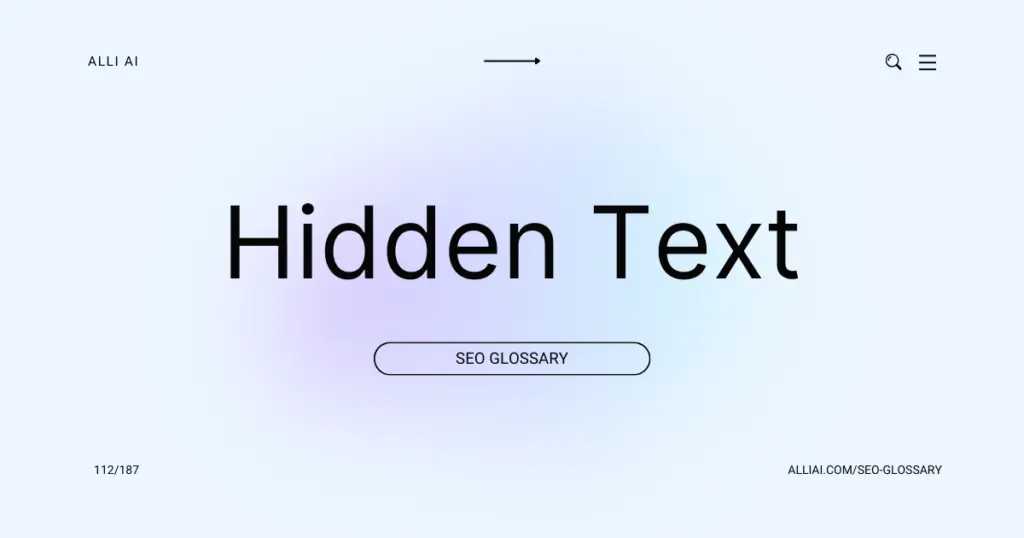What Does Hidden Text Mean?
Hidden text in SEO refers to text on a webpage that is not visible to the user but is readable by search engines. This might include text that is the same color as the background, positioned off-screen, or hidden by CSS techniques. It is often used inappropriately to include extra keywords on a page, which can be considered manipulative and might be penalized by search engines.
Where Does Hidden Text Fit Into The Broader SEO Landscape?
Hidden text is considered a black-hat SEO technique, which involves including text in web pages that is not visible to human visitors but is readable by search engines. This can be done by using CSS to make text the same color as the background, setting font size to zero, placing text behind an image, or using other methods to hide text from viewers but not from search engine crawlers. The intent of hidden text is often to stuff additional keywords into a page to manipulate search engine rankings.
This practice is against the guidelines of most search engines, including Google. Websites caught using hidden text can be penalized, resulting in lower rankings or even complete removal from search engine index listings. Search engine algorithms have become increasingly sophisticated at detecting such tactics and penalizing the sites that use them.
In summary, hidden text does not fit within the ethical SEO landscape and is strongly discouraged as it can lead to significant penalties and damage to a site’s reputation and long-term performance. Within the broader SEO perspective, focus has shifted towards more transparent and user-friendly strategies that align with search engine guidelines.
Real Life Analogies or Metaphors to Explain Hidden Text
Hidden text in SEO is like hiding ingredients in a recipe under the table. While visitors can enjoy the dish without seeing these ingredients, a health inspector (search engine) checking for complete transparency would penalize the chef for not disclosing everything used in the meal.
How the Hidden Text Functions or is Implemented?
Hidden text is text on a webpage that is visible to search engines but hidden from users. It is typically used for manipulating SEO by including additional keywords to influence page rankings. Here are common methods used to implement hidden text:
1. CSS Styling: Setting the font size to 0, making the text the same color as the background (e.g., white text on a white background), or using CSS positioning to move the text off the visible screen.
2. HTML Comments: Although not directly displayed on the page, some older search engines might mistakenly interpret content within comments as valid content.
3. Using Image Alt Attributes Improperly: Overstuffing ALT attributes with keywords that aren’t relevant to the image.
4. NoScript Tags: Inserting text within `noscript` tags, which are designed to display content when JavaScript is not enabled in the browser but may also be crawled and indexed by search engines.
Impact Hidden Text has on SEO
Hidden text, employing text in the same color as the background or positioned off-screen, negatively impacts SEO by violating Google’s Webmaster Guidelines. This deceptive practice can lead to penalties from search engines, including reduced rankings or complete removal from search results. For users, hidden text undermines trust and credibility if discovered, potentially decreasing user engagement and satisfaction.
SEO Best Practices For Hidden Text
1. Identify Hidden Text: Use tools like the W3C Validator or browser’s developer tools to examine your website’s HTML and CSS. Check for text that matches the background color, text positioned off-screen, text behind images, and text set to very small sizes.
2. Remove Hidden Text: Remove any instances of text intended to be hidden from users but visible to search engines.
3. Replace with Visible Text: If the hidden text is important for SEO (keywords, content), rewrite and incorporate it naturally within the content that is visible to all users.
4. Adjust CSS and HTML: Modify your site’s CSS and HTML to eliminate styles and tags that hide text. This includes zero font sizes, `text-indent`s used nefariously, colors that blend with the background, and `display:none` used improperly.
5. Adopt Progressive Enhancement: Use CSS for layout and JavaScript for behavior, not for hiding content. Where needed, ensure content that relies on JavaScript is accessible and readable even with JavaScript turned off.
6. Implement ARIA roles and attributes: For content that must be accessible but not immediately visible (like modal windows), use appropriate ARIA roles to ensure accessibility standards are maintained.
7. Verify with Tools: After changes, validate your website again with SEO and accessibility tools to ensure no hidden text remains unless it is compliant with accessibility guidelines.
8. Monitor Search Console: Regularly check Google Search Console for any manual penalties or automated notices about hidden text, and ensure compliance with Google’s Webmaster Guidelines.
9. Document Changes and Rationale: Keep documentation of what changes were made and why, ensuring you or others can reference this in the future for site audits or further SEO efforts.
10. Test User Experience (UX): Finally, test your website’s user interface to ensure that all textual information is easily accessible and provides value to the user experience, enhancing both SEO and user engagement.
Common Mistakes To Avoid
1. Using Text the Same Color as the Background: This is a technique used to include text on a page that is invisible to the visitor but readable by search engine bots. Avoid using this method by ensuring that all text contrasts with the background.
2. Using CSS to Position Text Off-Screen: Some developers move text off the visible area of the webpage using CSS (e.g., setting large negative values). Always keep important content within the visible web page layout.
3. Setting Font Size to Zero: Shrinking text to a size so small it becomes unreadable is another technique that should be avoided. Ensure all text is of a legible size.
4. Using Hidden Layers or Divs that can be Triggered by an Action: Text put in layers hidden from users unless an action like clicking a button is taken can be questionable. If you implement hidden divs, make sure the action to reveal the content is clear and intentional.
5. Using Noscript Tags Improperly: While `
6. Image Alt Attributes Over-Optimization: Stuffing keywords in image alt attributes under the guise of improving accessibility can backfire. Keep alt text relevant and descriptive of the image.
7. Zero-Opacity Text: Setting text at zero opacity to hide it from view but keep it readable by search engines is deceptive. Maintain full opacity for all text intended for reading.
Best practices include: making all content intended for users visible and easily accessible, using semantic HTML to structure content logically, and respecting user accessibility by design. Audit the site with accessibility tools to ensure visibility of all content.






